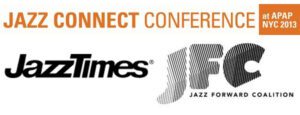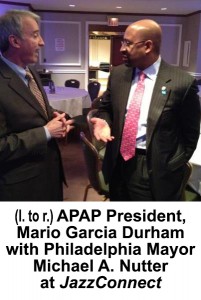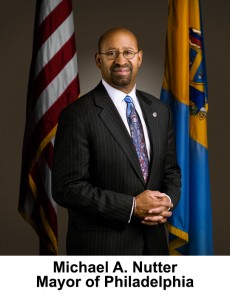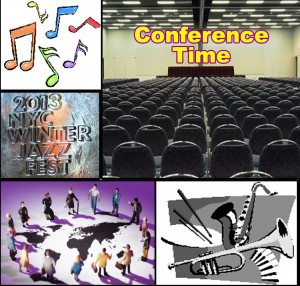‘Tis the season for conferences.
Last week (January 2-5, 2013) the Jazz Education Network held its 4th annual conference in Atlanta, GA (please see my blog #44). As of this writing, the Association of Performing Arts Professionals (APAP) is meeting in New York City at the Hilton (54th and Avenue of the Americas), January 11-15, 2013. January 11-12, Winter JazzFest again mounted a cornucopia of performances by jazzers of various stripes—75 acts in all at six Greenwich Village venues. Next week, January 17-20, Chamber Music America will host its annual meeting at the Westin in New York.
In between all these gatherings, Lee Mergner’s JazzTimes in conjunction with the Jazz Forward Coalition hosted JazzConnect, January 10-11, 2013, with generous support from the abovementioned APAP—APAP provided various spaces for JazzConnect at the Hilton.
 This recently concluded JazzConnnect was of significance for several reasons. First, it was the second year this conference was mounted. This by itself is no profound reason for celebration, but what was readily apparent from the get-go was the size of the attendance. Last year there were perhaps three hundred attendees packed into a decent sized room in the lower level of the Hilton Hotel (again, courtesy of APAP) for a one day series of panels.
This recently concluded JazzConnnect was of significance for several reasons. First, it was the second year this conference was mounted. This by itself is no profound reason for celebration, but what was readily apparent from the get-go was the size of the attendance. Last year there were perhaps three hundred attendees packed into a decent sized room in the lower level of the Hilton Hotel (again, courtesy of APAP) for a one day series of panels.
This year there were over 1,000 attendees. Concurrent workshops were held over two days! The buzz and conversational exchanges were passionate and constant. The workshops and plenary sessions were held on the Hilton’s third floor—no more lower level venue.
The content of the workshops were, in a way, the usual suspects: the impact of new technology, DIY issues, the state of jazz radio, and jazz as a global phenomenon.
 But wait, there’s more. Quite apart from the tripling of the size number of attendees one year to the next, the folks who organized JazzConnect took it up a notch. The first plenary session (on January 10)–that included a panel discussion entitled “Stories of Innovation & Inspiration”–had as a first speaker APAP President, Mario Garcia Durham. He, in turn, introduced the keynote speaker, Michael A. Nutter, Mayor of Philadelphia and President of the U.S. Conference of Mayors! Mayor Nutter’s speech was met with a standing ovation at its conclusion.
But wait, there’s more. Quite apart from the tripling of the size number of attendees one year to the next, the folks who organized JazzConnect took it up a notch. The first plenary session (on January 10)–that included a panel discussion entitled “Stories of Innovation & Inspiration”–had as a first speaker APAP President, Mario Garcia Durham. He, in turn, introduced the keynote speaker, Michael A. Nutter, Mayor of Philadelphia and President of the U.S. Conference of Mayors! Mayor Nutter’s speech was met with a standing ovation at its conclusion.
Below are a few of Mayor Nutter’s remarks:
Jazz is alive, and will never die.
Jazz is a unique American art form that affirms the noblest aspirations of our nation – individualism, discipline, perseverance, innovation…
As jazz saxophonist Charlie “Bird” Parker said, “Music is your own experience, your thoughts, your wisdom. If you don’t live it, it won’t come out of your horn.”
Jazz has produced some of America’s leading artists and ranks as one of our greatest exports to the world.
With its international popularity, jazz music has become a universal language that brings people of all races, ages and backgrounds together.
. . . .
In Philadelphia, we released a report in 2012 showing that more than 6% of our local economy is directly or indirectly linked with Arts & Culture, making it the 4th largest employment sector behind education, health care and retail.
That’s roughly 1 in every 15 jobs supporting the Creative Economy in Philadelphia – nearly 50,000.
. . . .
And while New Orleans is one of the most famous “jazz cities,” there are certainly many others.
Almost every major city in the America and around the world has some type of jazz festival, and there are hundreds of smaller towns that host events as well, some that you might not
expect like:
-Birmingham, Alabama
-Davenport, Iowa
-Burlington, Vermont
-Reading, Pennsylvania
… along with all the ones we all know like Chicago, Detroit, New York, Los Angeles & Monterey, California, Montreal, and Newport, Rhode Island.
In addition to adding to the cultural life of the city, these festivals are huge economic growth generators adding millions of dollars to local economies through hotel rooms, meals, night-life and transportation providers.
Jazz is celebrated in every state in the nation and in almost every nation around the world.
. . . .
Jazz is fire-y, spontaneous, riveting music that speaks to our souls.
We must do all that we can to sustain, nourish, preserve and promote the unique history and tradition of jazz in America.
Let me say it again, “Jazz is alive and will never die” – because we won’t let it!
 Mayor Nutter went into some detail regarding Philadelphia’s efforts to promote jazz in his city, including the formation in 2010 of the Philadelphia Jazz Coalition to help promote Philadelphia’s celebration of Jazz Month in 2011.
Mayor Nutter went into some detail regarding Philadelphia’s efforts to promote jazz in his city, including the formation in 2010 of the Philadelphia Jazz Coalition to help promote Philadelphia’s celebration of Jazz Month in 2011.
Nutter’s remarks made clear his awareness of the poor economics of being a jazz musician in the United States and the need to fix it. He stated: “The members of the Coalition are caring, dedicated professionals hoping to address issues faced by jazz artists and producers across the board. . . Issues like too few employment opportunities, low compensation for the opportunities that are available, lack of unity and cooperation among club owners and the musical community, and dwindling funding for music education programs.”
Once again, the issue of poor economics of those plying their trade in jazz, let alone the fine and performing arts, comes to the fore. It is an ironic conundrum. Jazz is America’s unique indigenous art form. It is appreciated and performed all over the world. Its progenitors from the first half of the 20th century are revered and remembered. Yet, today, jazz has become marginalized in the mainstream media and, for the most part, its professional practitioners struggle to make a living while putting their heart and soul into the music.
Broadly, speaking, in the jazz world, as in all of the performing arts, there are the two percent who make a very good living from their talent and virtuosity, and then there’s the rest, not quite as fortunate in talent and connections, nonetheless dedicated to the art, not living half as well. The disparity is disturbing. It parallels the economic divergence rooted in the early 1980s since the first Reagan administration. A little over 30 years later: the rich have gotten much richer, and the poor and middle class have stayed in place, perhaps even losing economic ground.
Part of the disparity is because Americans perceive that democracy and economic well-being is rooted in finance and technology. They don’t see the important connection between democracy, economic well-being, and the arts.
Please write to me at meiienterprises@aol.com if you have any comments on this or any other of my blogs.
Eugene Marlow, Ph.D.
January 14, 2013
© Eugene Marlow 2013


